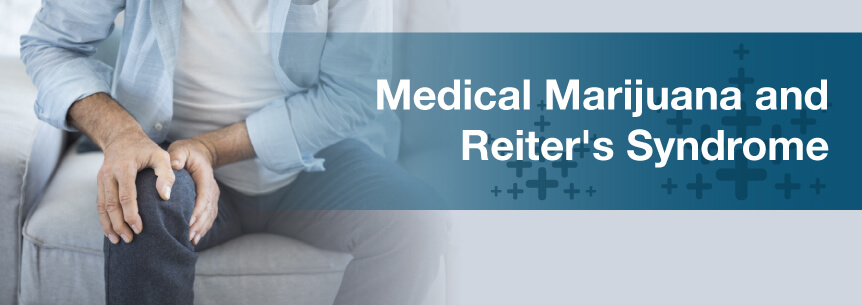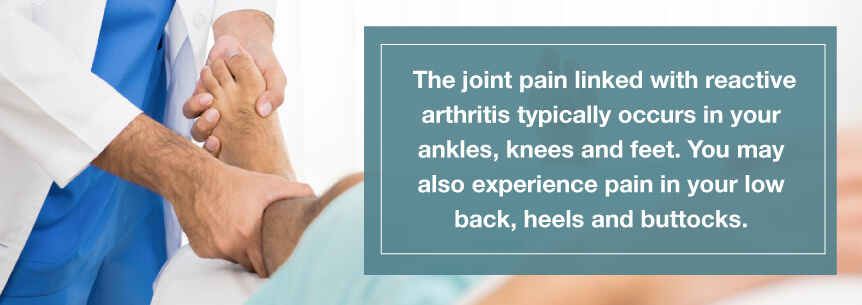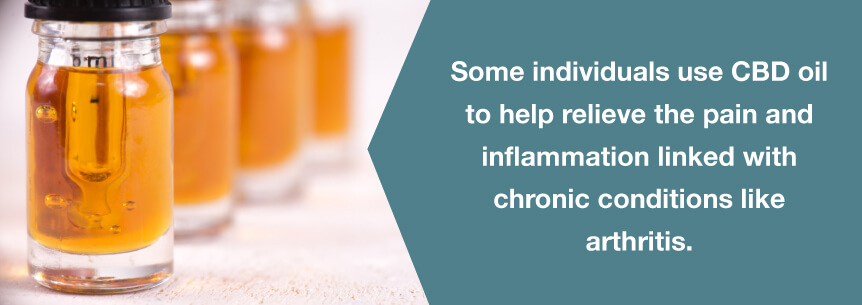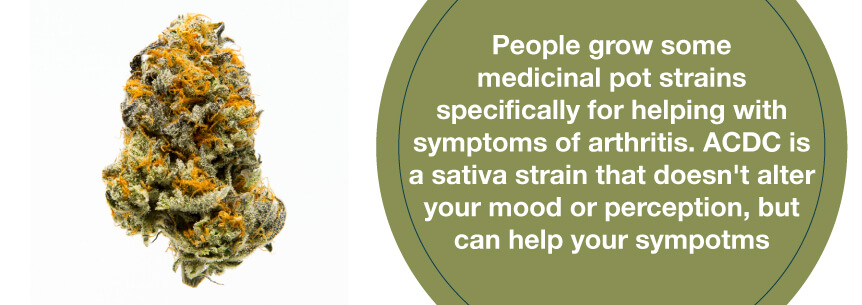
Arthritis, which includes Reiter’s syndrome, can severely impact the quality of your life. So, it’s a good idea to learn a little about how medical marijuana for Reiter’s syndrome works if you’re worried about taking too many traditional drugs that can come with harmful side effects.
Despite the scrutiny targeted at the herb for years, impressive new aspects of cannabis continue to crop up. For example, individuals now realize it has anti-inflammatory properties, making it an excellent alternative treatment for arthritis-type inflammation.
This condition is a type of seronegative arthritis involving mostly the peripheral joints, or your knees, wrists, ankles, elbows, shoulders, hands and feet. It occurs after an episode of diarrhea or urethritis, and associates with conjunctivitis, which is swelling or inflammation of the inner tissue surface of the eyelid.
Medical professionals often refer to Reiter’s syndrome as reactive arthritis, which is an inflammatory arthropathy that follows an infection where no viable microorganism is in the synovial fluid. Some doctors consider Reiter’s syndrome as a subset of reactive arthritis. The American College of Rheumatology explains reactive arthritis was formerly named Reiter’s syndrome, and it now belongs to an arthritis group called spondyloarthritis.
The chronic type of inflammatory arthritis combines three different conditions:
It’s a systemic rheumatic condition, which means it can and does affect not only your joints, but also other organs. It often causes inflammation in numerous areas, including the:
Evidence suggests Reiter’s syndrome is more common in men, but recent research suggests doctors may have underestimated the prevalence rate in women. Women tend to experience less severe symptoms than men, and they’re susceptible to genitourinary conditions, often causing a misdiagnosis.
Those with the HLA-B27 genetic marker have a higher risk of developing Reiter’s syndrome after sexual contact or exposure to a bacterial infection. Having a history of venereal or enteric infection further raises the risk of developing this condition. Individuals with HIV have a stronger incidence rate of Reiter’s syndrome. Research suggests in people with HIV, the condition more strongly connects with male homosexuality than with individuals with a history of risky behaviors like injecting drugs.
The symptoms and signs of reactive arthritis typically begin one to four weeks after exposure to a triggering infection. Symptoms may include:

You may experience inflammation of soft tissue where it enters bone, which could include tendons, muscles and ligaments.
The specific symptoms and their severity vary significantly between sufferers. Some people with reactive arthritis might merely develop mild arthritis without urinary tract or eye involvement. Others might end up having a more severe case of arthritis that can drastically limit their daily activity. Symptoms tend to last between three to 12 months and can come and go. In around 30 to 50 percent of individuals, symptoms might come back or become a chronic, long-term issue.
Reiter’s syndrome develops as a reaction to an infection in your body, usually in your genitals, intestines or urinary tract. You may not know about the triggering infection if it only causes mild symptoms or no symptoms at all.
Various bacteria can cause the condition. Some are foodborne, while others transmit sexually. Common types of bacteria are:
Reiter’s isn’t contagious, but the bacteria causing it can get transmitted in contaminated food or sexually. Only a few individuals exposed to these bacteria end up developing reactive arthritis.
Certain risk factors can increase your chances of developing reactive arthritis. These are:
Doctors categorize inflammatory arthritides that develop following a distant infection as either postinfectious or reactive. However, they often depend on the HLA-B27 status of the individual or the microbial trigger. Researchers propose they all should be under the umbrella of reactive arthritis or Reiter’s syndrome, which, based on the trigger, comes about as an HLA-B27 non-associated or associated form.
Along with the HLA-B27 and causative agents, you can distinguish the two categories by other characteristics. HLA-B27-associated arthritis might come on identical to Reiter’s syndrome, with the associated conjunctivitis or urethritis, whereas the B27 non-associated form does not. Additionally, only the B27-associated form goes along with the spondyloarthropathies group of inflammatory arthritis.

Reactive arthritis typically runs a self-limited course of three to 12 months, with up to 50 percent of individuals experiencing recurrent bouts of arthritis and 15 to 30 percent developing chronic symptoms of the condition. Extra-articular manifestations provide essential support for diagnosing reactive arthritis, including:
However, neurological complications aren’t that common. There have only been a few cases reported of cranial nerve palsy, polyneuropathy or myelopathy in Reiter’s syndrome.
Mental health, pain and disability are strongly associated with Reiter’s. Therefore, not recognizing or treating one can significantly impact the others.
For instance, if you have depression, chances are you don’t have the energy or will to exercise, leading to loss of function. Or, if you’re experiencing inflammation and pain, it can make it more difficult to work out, causing you to become anxious or depressed. Eventually, this vicious cycle can harm your:
Facts about Reiter’s syndrome, according to the National Center for Biotechnology Information, include:
Antibiotics — If a bacterial infection triggered your Reiter’s, the doctor might give you a prescription for antibiotics if there’s evidence of persistent infection. The type of bacteria present will determine the medication you get prescribed.
Side effects of antibiotics may include:
For your pain and inflammation, your doctor may suggest:
Nonsteroidal anti-inflammatory drugs (NSAIDs) — They might prescribe NSAIDs like Indocin to help relieve these symptoms of reactive arthritis.
Side effects of NSAIDs may include:
Corticosteroids — The doctor may inject corticosteroids into your affected joints to reduce inflammation and enable you to get back to your regular activity level.
Side effects of corticosteroids may include:
Topical steroids — These may help with reactive arthritis-related skin rashes.
Side effects of topical steroids may include:
Your doctor may refer you to a physical therapist who will provide you with specific exercises to target your muscles and joints. Strengthening exercises can help increase your joints’ support because they develop your muscles around the affected joints. Range-of-motion exercises can help reduce stiffness and increase flexibility in your joints.
Basic research into the host-pathogen and biology interactions characteristic of C. trachomatis offered a lot of information that underlies the present knowledge of the pathogenic processes that occur in the ReA synovium. Also, an approach that looks promising to cure Reiter’s syndrome is at hand. But, both clinical and basic research into chlamydia-induced Reiter’s has been lagging over the past five years, including research related to curing the disease.
Research suggests CBD oil can play a role in arthritis treatment. CBD oil contains cannabidiol extracts from marijuana plants. Some individuals use CBD oil to help relieve the pain and inflammation linked with chronic conditions like arthritis. Studies show CBD oil might be helpful for chronic pain and other disorders.

Some animal studies suggest CBD could help with the treatment of arthritis and relieve the related inflammatory pain. These studies include:
As is the case with most types of arthritis, a person suffering from Reiter’s syndrome can experience a considerable amount of pain every day. The inflammation this condition causes can interfere with everything from your job to your basic enjoyment of life.
Doctors commonly prescribe NSAIDs to try and reduce the inflammation Reiter’s syndrome causes. While these drugs may work, they can cause significant and dangerous side effects such as digestive tract problems and irreparable damage to internal organs. Medical marijuana offers a much gentler, yet equally valid, treatment option.
Often, the pain that results from Reiter’s requires treatment with opiate-based pain medications. As with NSAIDs, these medications do work for a time. However, not only do they come with side effects such as nausea, diarrhea and the risk of dependency, but they also lose their effectiveness over time. Medical marijuana offers pain relief without all these adverse risks and considerations.
Most people are aware various cultures have used marijuana for centuries as an effective analgesic to combat moderate to severe pain. Recent studies on medical marijuana have confirmed what many medical practitioners have known for centuries. One recent study looked at how adding medical marijuana to an opiate-based pain medication regimen impacted the study participants.
The study showed patients who added medical marijuana as part of their daily routine of taking opiate-based medication for chronic pain were able to lower the amount of opiate-based pain medication they needed to achieve the same reduction in pain.
While most people are familiar with medical marijuana’s ability to combat pain, most people do not realize medical marijuana has also proven highly effective as an anti-inflammatory drug. Along with THC that helps reduce pain levels, medical marijuana also contains cannabidiol, or CBD, which has anti-inflammatory properties. The CBD in medical marijuana, therefore, can also help reduce the inflammation Reiter’s syndrome causes — without resulting in further injury to the patient’s digestive tract or internal organs, as is the case with conventional NSAIDs.
Marijuana for Reiter’s syndrome can help treat the following symptoms:
Pain is one of the primary symptoms of reactive arthritis sufferers deal with daily. The pain they experience causes a great deal of discomfort and interferes in their everyday activities. Doctors commonly prescribe NSAIDs to help reduce the pain and inflammation.
While NSAIDs can help with these symptoms, they can also cause irreversible internal organ damage, along with adverse side effects like:
For this, medical cannabis for Reiter’s syndrome is a safer treatment option, providing no severe side effects and still relieving their inflammation and pain.
Medical cannabis does have some side effects, however, but they’re mild and may include:
Medical pot is an immune system modulator as well as an anti-inflammatory drug. CBD improves mobility, suppresses the immune response and reduces morning stiffness and inflammation.

People grow some medicinal pot strains specifically for helping with symptoms of arthritis. Some good medical marijuana and Reiter’s syndrome strains are:
Chronic pain can significantly impact your psychological and emotional well-being. These strains can gently enhance your mood and are suitable for patients experiencing anxiety and depression along with their physical symptoms.
Your body requires sleep to heal itself. Insomnia is an unfortunate side effect for many arthritis sufferers. Here are some perfect cannabis for Reiter’s syndrome strains to help relieve your insomnia and help you get quality sleep:
Do not undertake any medicinal therapy without the guidance of a doctor or another health care professional who has the right experience and training. Doctors are recommending medical marijuana more often as an alternative or supplement to prescription drugs, which often have severe side effects and addictive properties. To get the most out of your medical marijuana and Reiter’s syndrome treatment, you need to find a delivery method that suits you. Some include:
When you smoke medical weed, try to keep in mind a common side effect is bloodshot and irritated eyes. So, if you’re using medical pot to treat conjunctivitis with your Reiter’s syndrome, you may want to choose a different delivery method.
Now that you know how marijuana for Reiter’s syndrome can treat your pain, inflammation, depression, anxiety and other unpleasant symptoms of the condition, it’s time to get yourself a qualified, licensed cannabis doctor who can help you with your next steps in beginning your medical cannabis therapy. Book your appointment with one of our cannabis doctors today and find a cannabis dispensary to buy your products once you’ve received your recommendation for treatment.
Find A Doctor Find A Dispensary